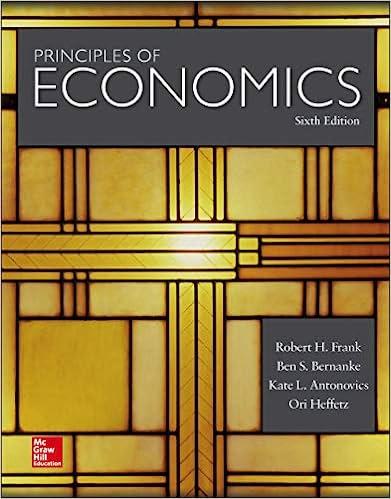Question
We consider some issues relating to the evaluation of price changes. Recall that, in a two-good setting, a consumer is modeled to maximize the utiity
We consider some issues relating to the evaluation of price changes. Recall that, in a two-good setting, a consumer is modeled to maximize the utiity function U(x1, x2) subject to the budget constraint p1x1 + p2x2. In the following, the notion, "better off" is the same as "higher utility" and "worse off" is the same as "lower utility"
. 5.1 Suppose that both prices increase and the consumer's income increases as well. The consumper's original consumption bundle was, say, (20, 20) and the new consumption bundle is (32, 8). Under what cases does revealed-preference theory tell us that the consumer is now worse off? How about being better off? Suppose we have a consumer who tells us that "each year I find that I can no longer afford the things I used to buy last year." Does this tell us the consumer is becoming worse off? Explain.
5.2 Now consider two years, the "base year" and the "target year." Suppose that in the base year we have prices (p b 1 , pb 2 ). Then the price of good 1 increases to p t 1 > pb 1 , and the price of good 2 decreases to p t 2 < pb 2 . We want to find an index that allows us to say either "prices are higher" (i.e., there has been inflation) or 6 "prices are lower" (i.e., there has been deflation). Consider the proposal that the price index is given by p1+p2. Give an example of base-year and target-year prices so that the price index has increased if good 2 is measured in kilograms, and decreased if good 2 is measured in tons.
5.3 Consider the general case in which there are n consumption goods. We want to construct an index of prices that will measure how much prices have increased from the base to the target year. Consider the following proposal of such an index of prices, the ratio of average prices: p t 1 + p t 2 + + p t n/ p b 1 + p b 2 + + p b n where p t i is the price of good i in the target year and p b i is the price of good i in the base year.
5.4 There have been various proposals of price indices by economists and we turn to some of them next. A basic idea behind those proposals is that they are to compare weighted prices averages, where the weights are the quantities of the various goods consumed. let x b i be the quantity of good i consumed in the base year and x t i the quantity of good i consumed in the target year.
Note that the Paasche index uses target-year quantities as weights, the Laspeyres index uses base-year quantities as weights, and the expenditure index uses a mixture of both. Use revealed-preference theory to argue that, i) if the Paasche index exceeds the expenditure index, then the consumer was better off in the base year, and ii) if the Laspeyres index is smaller than the expenditure index, then the consumer is better off in the target year (in the sense that "prices are lower" in the target year).
5.5 Consider the case of two goods and the utility function is given by U(x1, x2) = (x1+10)(x2+1). Find an example (including a level of income, base-year prices, and target-year prices) in which the Paasche index is lower than the expenditure index, but the consumer is better off in the target year. Find another example in which the consumer is worse off in the target year.
5.6 The Laspeyres price index is used in practice. This is the only one we can probably manage to calculate. Typically, we have data on quantities consumed only during the base year. Let us examine the implications of using the Laspeyres index. Consider our earlier example with two goods and the utility function U(x1, x2) = (x1 + 10)(x2 + 1). Let p1 = 10 and p2 = 20 and I = 400. Find this consumer's optimal consumption bundle and the resulting utility.
5.7 Suppose now that p1 = 10 and p2 increases to 30. Find the Laspeyres price index for this change in prices. Now let us compensate for the increase in prices by multiplying this consumer's income by the Laspeyres price index to obtain a new income. Hence, if the index is given by a, this consumer's new income is 400a. Find the new income, and the consumer's optimal consumption bundle and the resulting utility, at the new income and price levels. Compare this utility to that of 5.6.
5.8 Given your answers to the above two parts, explain in what sense the Laspeyres price index may overstate the rate of inflation. Can you argue that this is a general phenomenon independent of the particular utility function, prices, or incomes that were used in the earlier example? You may draw a didagram with the original budget line and indifference curve as well as the new budget line to help sharpen your intuition and formulate your argument. Can you think of any advantages and disadvantages of using the Laspeyrers index to adjust benefits to the recipients of a social security scheme?
Step by Step Solution
There are 3 Steps involved in it
Step: 1

Get Instant Access to Expert-Tailored Solutions
See step-by-step solutions with expert insights and AI powered tools for academic success
Step: 2

Step: 3

Ace Your Homework with AI
Get the answers you need in no time with our AI-driven, step-by-step assistance
Get Started


